How to make more in the same time?
In video game player always wants more, they want to see more stuff happening on the screen with high quality of graphics. They want to have more interaction with the world like the ability to destroy everything they see while not having objects passing through each other in a weird way. If this kind of game is feasible on high end PC specialized in video game, this is still some hard time when working on consoles or any kind of mobile device. One solution to do more with the same amount of time (16.66 ms per frame can be considered a default value) is to multitude the engine.
Introduction to multithreading
What’s multithreading
To really understand the concepts of multithreading we have to take a look inside a computer (console and mobile works in the same ways, but for the sake of keeping it short they’ll be ignored). Computer are composed of different hardware parts and the one doing most of the computation is the CPU (central processing unit) it handle most of “logical” computation. When you’re doing 2 + 2 on a computer, it’s the CPU that does this. There is another one which is the GPU (graphic processing unit) that display everything on the screen. Both of them can execute multiples “task” at the same time, by example you can listen to music while writing text.
This is possible because our CPU and GPU are what is called Core. This part is in charge of the calculus and they are a physical part of the modern processing unit. Each core can use Threads that are considered as a logical core. This can be seen as both arms of a human. With each arm you can do two different tasks or you can try to do 4 tasks, two with each arm, you won’t twice as fast, but you’ll still be doing four tasks at the same time
Why using multithreading in games
Because multithreading works well when the computer is doing two different tasks. Make an enemy fire at the player is not the same task as drawing each light on the scene. Loading a resource (music, image, 3d object) can be done while the game is already launched without the need to pause the game.
But it’s not as easy as it seems. Let’s retake the example of the enemy who is shooting at the player. When the enemy shoot, it will instantiate a bullet that move via a physical body. Each frame the bullet will be moved, meaning that its position in the world will change. But what happen if at the exact same times the threads in charge of rendering (we’ll call it the rendering thread) everything try to display the bullet? Sometime nothing, the rendering thread just displays the object at the wrong position. Another time the programme will instantly crash.
Those are called race condition and can be pretty common when a programme is multithreaded. There are two kinds of solution.
- The first one where you lock the information while reading or writing it. But this solution is very costly in terms of performance and will drastically slow down our game.
- The second type is trying to avoid the possibilities to write and read from two different places, it can be done quite easily if this idea is in the mind of everyone from the first day of the project.
Example in AAA game engine
When regarding what is doing the major companies, there is different solutions implemented and this show something, even if multithreadings has been around for decades, there is not a general solution that works in every case. This is something to keep in mind while multithreading a game, it should work for your game, not for every game.
Implementation
Objectives for the engine
The main objective is to avoid having any locked data, the objective is to have complete separate data than can be accessed any time without the need to make sure to lock their access from anywhere else.
Using this technique has one other benefits, the other programmers just need to know when it is safe to access each type of data without worrying about race conditions. Doing so they can focus on their own part.
Using 4 threads simultaneously
For the implementation, we went with 4 different threads active at the same time, it matched the available number of threads on the switch.

App Thread
The one in charge of all the logic of the game:
- Moving objects
- Enemies firing at the player
Render Thread
It where everything is drawn on the screen. All data will be prepared then sent to the gpu at once. Vulkan (our graphics api) come with some functionalities dedicated to work with multithreading.
Audio Thread
We choose the api FMOD for handling all of our sounds in the game and it comes with a native separated thread system that allow to play music or sound on another thread without blocking any other thread.
Worker Thread
This thread is here to support the other threads in some task like loading resources, or computing some texture used by the graphics engine. It can also be used by the game if they have some heavy calculation where they don’t need the result immediately.
Being one frame behind
Using this technique has one drawback. If in the frame 1 the enemy is moving, it also means that it’s drawn using its previous position of the frame 0. And when finally at the frame 2, the Render Thread gets the position from the previous frame, the enemy has kept moving and is in a new position.
The Render Thread will always be one frame behind and in our game this is not a problem. When weighting between having twice as many objects or not being 16.66 ms seconds late, the choice was easy to make. Our game doesn’t rely on the player’s reflex, the accent is put on the number of explosion and object he can see at the same time. So the drawback is in fact not a drawback for us.
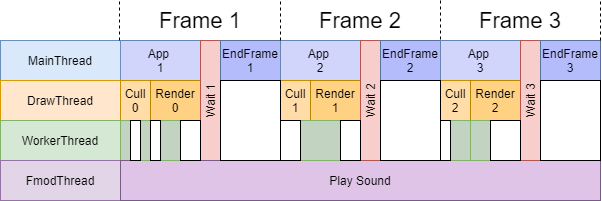
Create an execution loop
To have a safe moment where data can be accessed without having to bother with race condition, the execution loop - in which order the main function of the engine will be executed - has to be a priority when designing the engine.
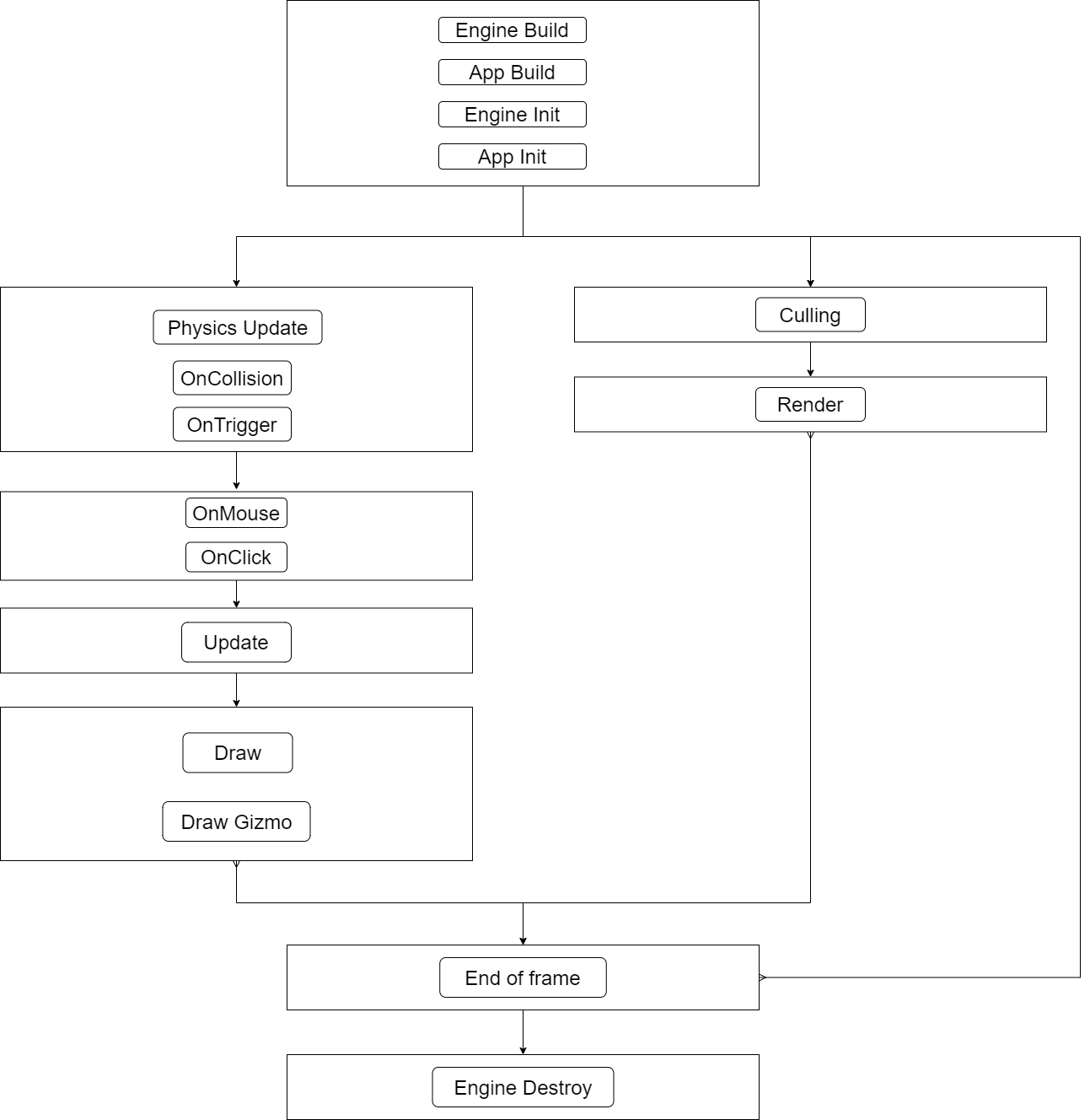
Each of those names can be seen as a set of functionality that are created anywhere in the engine and that will be executed following the order of the diagram.
Logic Thread
PhysicsUpdate
The first function to occur are related to physics. It assures that the elapsed time between each physical update is as close as possible. This has been made possible because the engine force a frame to be at least 16.66ms. In this pass every physical object is moved according to their speed and if two objects touch each other then message are sent to the system that are listening in case two objects are touching each other.
We made the choice to don’t resolve position by updating the position and velocities of objects. It was made because the game simply doesn’t need it. When two objects enter with each other it will end up in one of them being destroyed.
Input
After all, physical objects have been updated, every input that has happened are registered. It handles input from mouse, gamepad and the switch controller. This part also handles interaction with the windows like resizing or minimizing the window.
Update
Those function are mainly used by the game team to do all the logic it can implies :
- Moving object
- Firing at the player
- Updating lifetime of a projectile
- Change the color of a light on a spaceship
Draw
The graphics engine - a sub engine in charge of drawing stuff on the screen - needs a specific set of data to render an object and those data are created at that precise moment. For example, when drawing the player on the screen the graphics engine only few information (position, 3d mesh, materials) but doesn’t need to know the current health of the player.
Render Thread
Culling
This part works directly with the data created in the Draw pass. It will check if the object really needs to be drawn. There is a different reason for it not be drawn:
- Not visible by the camera (call frustum culling)
- Hidden by an another object (call occlusion culling)
- Too small on the screen (Not sure there is a name for it) |Gif frustum culling|
Currently the engine only implements frustum culling, but also use a custom type culling, the world is divided in chunks - rectangle- that contains all static objects that are updated from the player’s position.
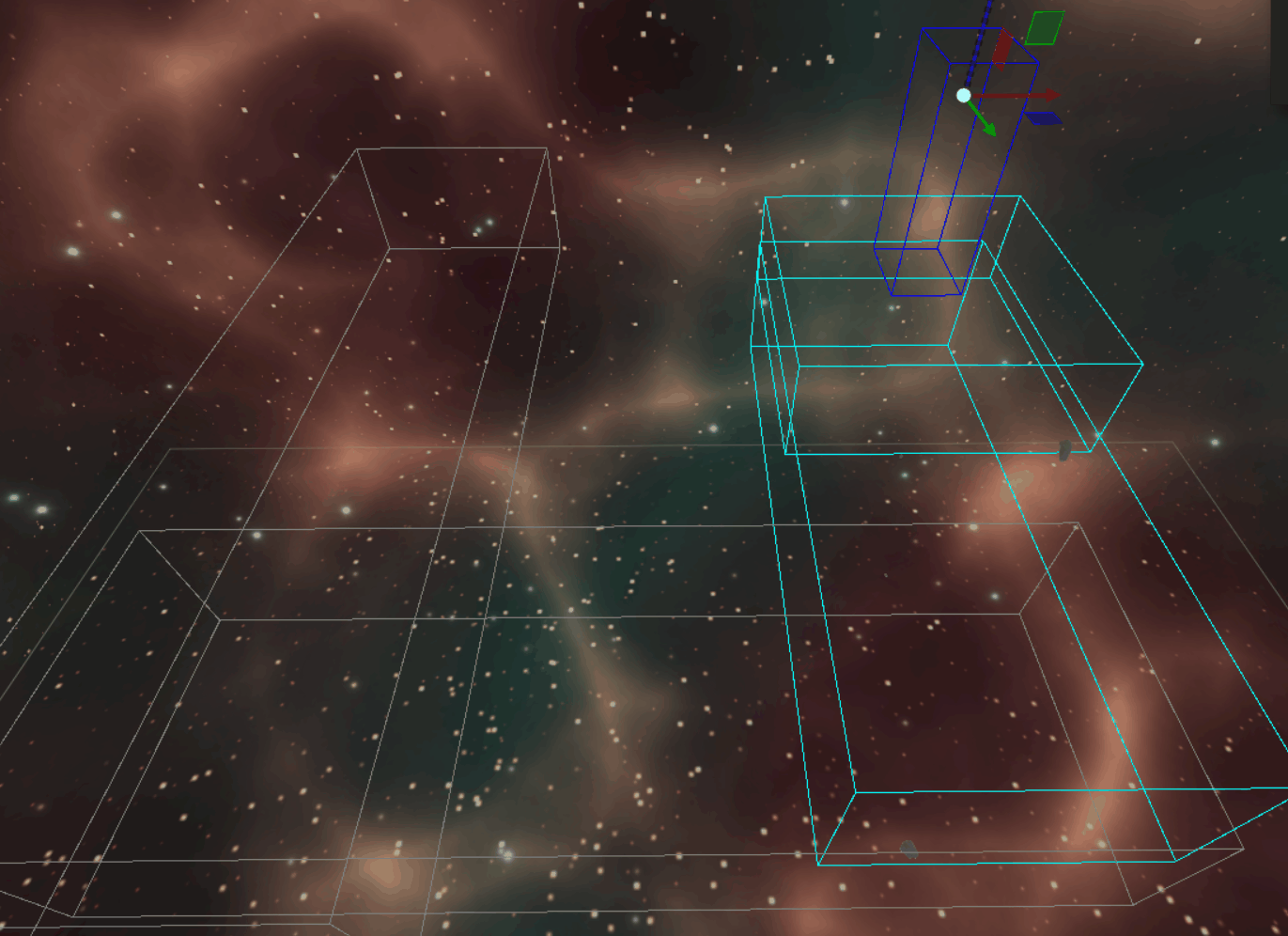
Render
Rendering happen in this pass, in fact, this is only calling the rendering function of the graphics engine where every data sent to the graphics engine in coupling function are sent to the gpu to be drawn.
End of frame
There is a single function in this part and this function is special because it has been made sure that there is no other threads working at the same time. It means that every data access is 100% race condition free.
This is also here where if the scene needs to change or be reloaded that it will happen. It’s the same reason as earlier, the goal is to make sure that everything can be accessed without anything else accessing it at the same time.
Copying data from one thread to an another
One critical part when using this type gameplay loop is when you copy data for several reasons.
Size of the datas
By having copies of data, the size of the engine can easily double if everything is copied from the logic thread to the render thread. But an important part is to know what is needed to draw something. By example the trails renderer :
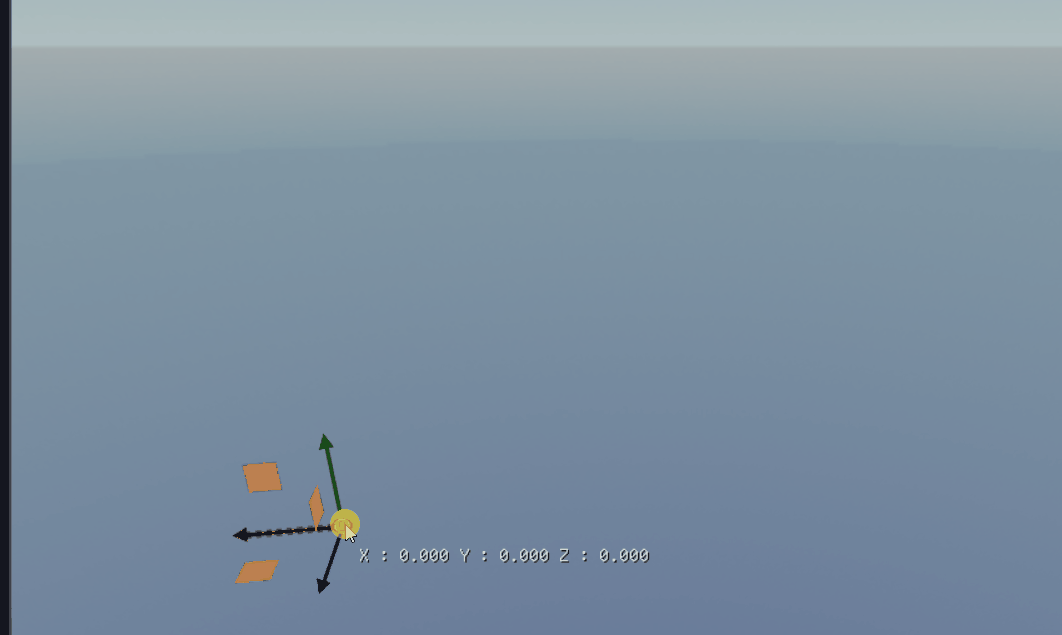
To calculate the movement, the next position, how the mesh will be created the trail renderer needs a lot of data.
struct TrailRenderer{
ResourceID materialID; // size_t
float lifetime = 1.0f;
float changeTime = 0.5f;
float widthStart = 1.0f;
float widthEnd = 1.0f;
float vertexDistanceMin = 0.1f;
math::Vec3 renderDirection = {0, 1, 0};
bool isPaused = false;
private:
std::vector<math::Vec3> centerPositions_;
std::vector<TrailRendererVertex> leftVertices_;
std::vector<TrailRendererVertex> rightVertices_;
};
struct TrailRendererVertex{
math::Vec3 centerPosition;
math::Vec3 derivedDirection;
math::Vec3 position;
float creationTime;
float timeAlive;
};
But to be drawn the trail renderer need less data, only the index of the materials that is already in the gpu when the engine is launched, the mesh who is also the gpu and an index to be drawn in the forward pass (a forward pass is a special type of pass where every object is drawn alone on the screen).
struct TrailRenderDrawData{
ResourceID materialID;
ResourceID meshID;
ModelForwardIndex forwardIndex; //size_t
};
The main point is the size of the structure which is way smaller and thus fixing this issue when copying data from the logical thread to the render thread.
Time to allocate memory
Allocation of memory is one of the worst parts in modern CPU. Here is an example where there is an already created array and then a new element is added to this array.
The problem here is that the computer doesn’t know what come after the existing array so it will need to look over the memory to find a new spot, it does mean to copy all memory somewhere else in memory
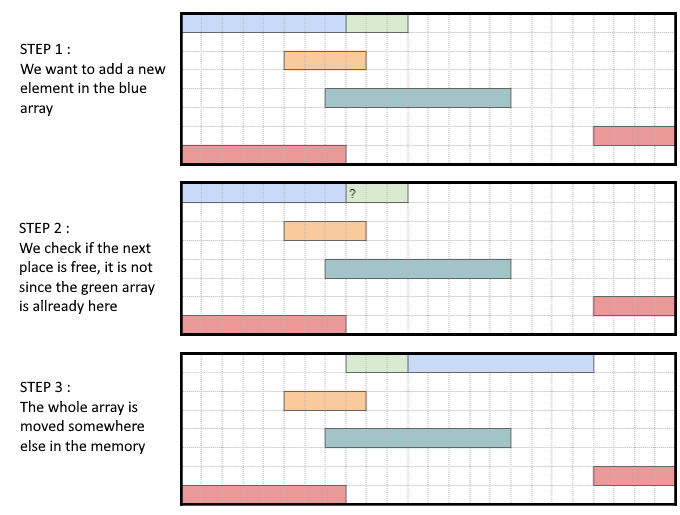
It’s easy to imagine what would happen when copying data from one array to the other. Fortunately, there is solutions to avoid allocation during the game is running. One of them is knowing the number of elements that can be drawn at the same time.
Let’s take an actual situation in the engine, due to gpu performance the number of light drawn at the same time has been limited to 256. It does mean also that the size of an array can know exactly from the moment the engine start to the moment it’s shut down.
This imply to reserve space in memory in advance
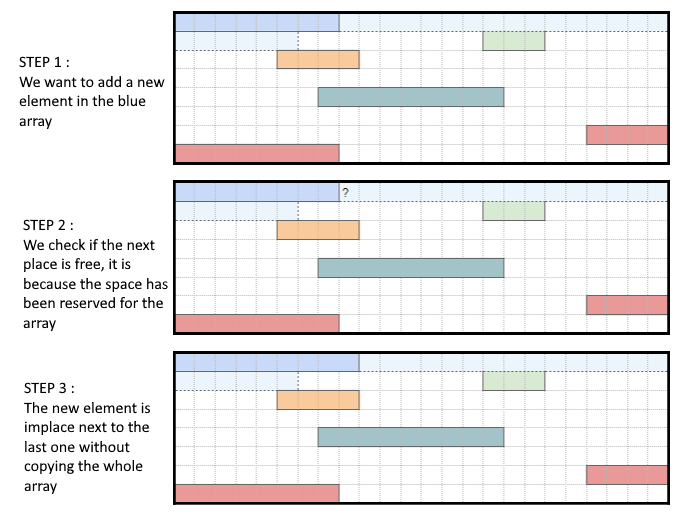
After thoughts
Pro and cons of the implementation
This is an easy implementation and easy to maintain and it perfectly fit our needs. But for bigger games that need even more stuff to happen there is a major drawback with this implementation. If the logic thread has finished all its work, it will just wait.

There are a few other solutions that can fix this problem, but that way are more complex like a job system. In the current states of the engine, optimization on the multithreading are not required and as it doesn’t need a lot of maintenance this implementation will certainly last until the end of the project.
Good resources
- Fleury, R., 2020. Entity Memory Contiguity: A Tale About Simplicity. Ryan Fleury. Available here. An interesting blog about data alignment and hwo to deal
- Gameprogrammingpatterns.com. 2020. Table Of Contents · Game Programming Patterns. Available here. This is a collection of programming pattern that can be solved a lot of differents architecture problem when designing the architecture.
- Schott, M., 2020. Developer.nvidia.com. Available here. This is a complete presentation on how to use Vulkan obejct to help multithreading the graphics engine